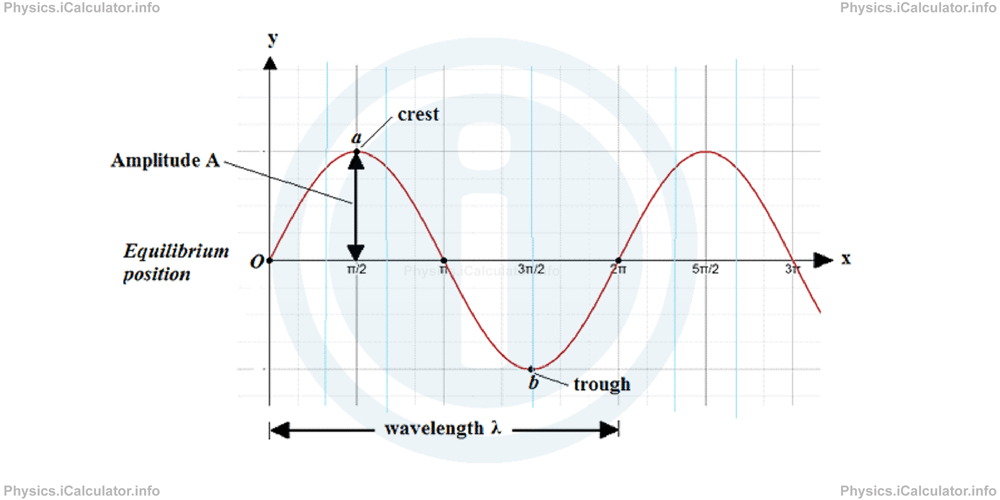Menu
Physics Lesson 11.1.2 - Elements of a Wave
Please provide a rating, it takes seconds and helps us to keep this resource free for all to use
Welcome to our Physics lesson on Elements of a Wave, this is the second lesson of our suite of physics lessons covering the topic of Types of Waves. The Simplified Equation of Waves, you can find links to the other lessons within this tutorial and access additional physics learning resources below this lesson.
Elements of a Wave
Consider the wave shown below.

The equilibrium position shows a horizontal line that shows the rope, water surface, etc., if no wave were present. When the wave is shown in a coordinate system, the equilibrium position is at the horizontal axis.
The highest point of a wave is known as "crest". In the above figure, crest is shown by the point a.
The opposite of crest is known as "trough". It is shown by the point b in the above figure. Trough represents the lowest point a wave can reach.
Waves represent a periodical motion. This means the cycle repeats itself periodically. The distance between two similar points of two successive cycles is known as "wavelength". It is denoted by the Greek letter λ (lambda). Wavelength is similar to the circumference in rotational motion, i.e. it shows the distance the wave travels during an entire cycle.
Like in rotational and simple harmonic motion, the time needed to complete one cycle is called "period", T. Also, the inverse of period is known as frequency, f as well. Frequency represents the number of cycles in one second. It is very important, especially when the vibrations are very fast.
You have reached the end of Physics lesson 11.1.2 Elements of a Wave. There are 4 lessons in this physics tutorial covering Types of Waves. The Simplified Equation of Waves, you can access all the lessons from this tutorial below.
More Types of Waves. The Simplified Equation of Waves Lessons and Learning Resources
Whats next?
Enjoy the "Elements of a Wave" physics lesson? People who liked the "Types of Waves. The Simplified Equation of Waves lesson found the following resources useful:
- Elements Feedback. Helps other - Leave a rating for this elements (see below)
- Waves Physics tutorial: Types of Waves. The Simplified Equation of Waves. Read the Types of Waves. The Simplified Equation of Waves physics tutorial and build your physics knowledge of Waves
- Waves Revision Notes: Types of Waves. The Simplified Equation of Waves. Print the notes so you can revise the key points covered in the physics tutorial for Types of Waves. The Simplified Equation of Waves
- Waves Practice Questions: Types of Waves. The Simplified Equation of Waves. Test and improve your knowledge of Types of Waves. The Simplified Equation of Waves with example questins and answers
- Check your calculations for Waves questions with our excellent Waves calculators which contain full equations and calculations clearly displayed line by line. See the Waves Calculators by iCalculator™ below.
- Continuing learning waves - read our next physics tutorial: General Equation of Waves
Help others Learning Physics just like you
Please provide a rating, it takes seconds and helps us to keep this resource free for all to use
We hope you found this Physics lesson "Types of Waves. The Simplified Equation of Waves" useful. If you did it would be great if you could spare the time to rate this physics lesson (simply click on the number of stars that match your assessment of this physics learning aide) and/or share on social media, this helps us identify popular tutorials and calculators and expand our free learning resources to support our users around the world have free access to expand their knowledge of physics and other disciplines.